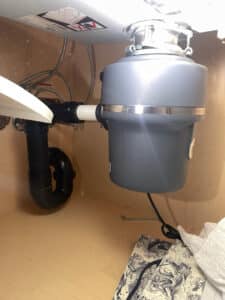Garbage dispenser (garburator) under your kitchen sink
Having a garbage garburator under the kitchen sink may seem like a convenient solution for disposing of food waste, but it has several disadvantages. One major issue is grease collection, which leads to blocked drain pipes and requires regular maintenance and cleaning.
A garbage garburator under the kitchen sink becomes susceptible to accumulating grease from food waste. Over time, this grease can build up and solidify, leading to clogged pipes and drainage issues. The accumulation of grease not only affects the functionality of the garbage garburator but also poses a potential health hazard.
Regular maintenance and cleaning are essential for ensuring the proper functioning of a garbage garbage generator. However, when it is placed under the kitchen sink, accessing and cleaning it becomes more challenging. The cramped space and proximity to other kitchen essentials make it cumbersome to perform routine maintenance tasks.
A garbage garburator under the kitchen sink also increases the risk of unpleasant odors. Food waste decomposes quickly, especially in warm and humid environments, resulting in foul smells that can permeate the kitchen. These odors can be challenging to eliminate and require frequent cleaning and deodorizing efforts.
To overcome these disadvantages, it is recommended that alternative locations for garbage disposal be considered. Placing it in a more accessible area, such as a dedicated cabinet or a separate kitchen section, can make maintenance and cleaning easier. This also helps prevent grease accumulation and reduces the chances of drain pipe blockages.
In conclusion, having a garbage garburator under the kitchen sink may initially seem convenient, but it has its fair share of disadvantages. The grease collection, the risk of drain pipe blockages, and the need for regular maintenance and cleaning make it a less-than-ideal choice. Exploring alternative locations for the garbage garburator can help mitigate these issues and ensure a more efficient and hassle-free waste disposal system in the kitchen.
Plumbing tips to use garbage dispenser (garburator)
When using a garbage disposal, it is recommended to use cold water rather than hot water to avoid melting grease. Cold water helps to solidify the grease, making it easier for the garbage disposal to break it down and prevent it from sticking to the walls of the pipes.
Using hot water while operating a garbage disposal can cause the grease to liquefy and coat the inside of the pipes, leading to potential clogs and blockages. On the other hand, cold water helps keep the grease in a solid state, allowing the disposal to grind it into smaller pieces that can be safely flushed away.
To properly dispose of food waste and grease using a garbage disposal, follow these steps:
1. Start running cold water before turning on the garbage disposal.
2. Turn on the garbage disposal and let it run for a few seconds to create a strong water flow inside the unit.
3. Slowly feed small amounts of food waste into the disposal, allowing it to grind the waste into small particles.
4. Continue running the cold water for a few seconds after using the garbage disposal. This helps to flush away any remaining debris and prevent clogs.
Never pour fats, oils, or greasy substances directly into the garbage disposal, as they can solidify and cause blockages. Instead, dispose of these items in a separate container and discard them in the trash.
Using cold water when operating a garbage disposal can help prevent grease-related issues and maintain the proper functioning of your kitchen plumbing system.



